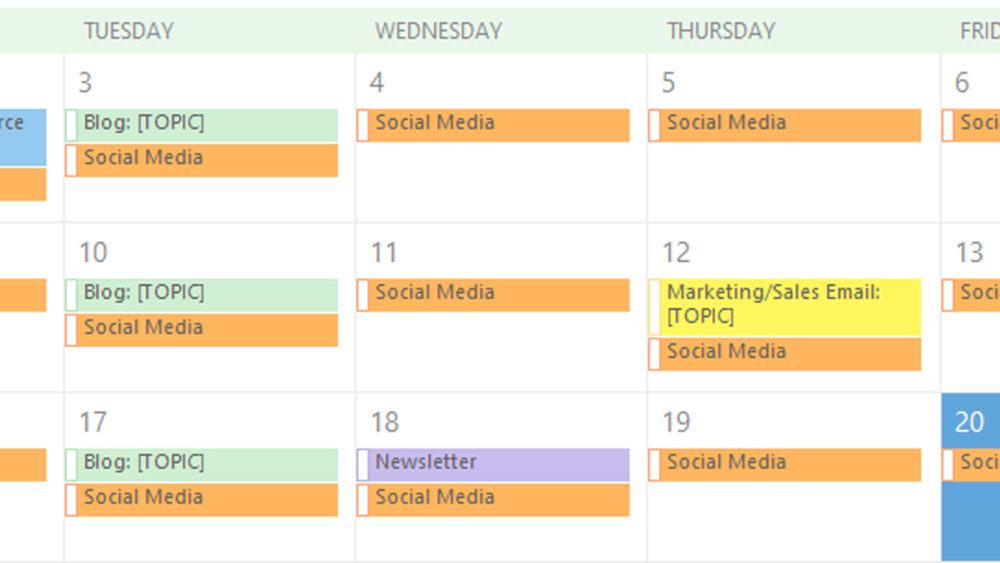Producing consistent, high-quality content is a challenge for many small and medium-sized B2B companies. Most companies we work with have one person or a very small team of people tasked with creating valuable content to attract and engage leads. With the limited amount of resources available, it’s difficult to deliver great blogs, social media posts, emails, and downloadable resources. Fortunately, content calendars can help.
Content calendars help plan for, deliver and track marketing efforts across multiple channels. This is critical for consistent community engagement and lead nurturing.
When developing a content calendar, the most important concepts to keep in mind are message, medium, and cadence. How frequently your company produces and promotes content is just as important as the message itself. Consistency is key, and scheduling content in a calendar is a great way to hold yourself or team accountable. With a realistic plan in place, it becomes easier to create valuable content that generates and nurtures sales leads.
What is a Content Calendar?
Content calendars are strategic marketing documents that show a scheduled viewpoint of upcoming communications and audience engagement opportunities. It encompasses a wide range of communication channels, including website blogs and news, company events, social media posts, email (newsletters, nurture campaigns), and downloadable lead-generation resources.
While content calendars need to be tailored to each individual company’s strategy and available resources, all address three core questions:
- What content should we develop?
- When should we post/send the content?
- Where should we publish/send the content?
Some additional – more advanced – considerations could include:
- Who is this content being created for? (Buyer’s Journey)
- Why is this content being created? (Call to Action)
- How are the results being tracked? (Content Analytics)
While content calendars can become quite complex with some of the additional considerations listed above, they can also be quite simplistic yet effective when sticking to the bare minimum. The only difference is in the results generated; when considering conversion pathways and measuring the conversion rate of content, it’s easier to figure out what’s working and produce more content with positive ROI.
While it’s possible to build a content strategy without a calendar, we find that more people tend to commit to a calendar approach.
Content calendars are more tangible than a written plan and can integrate seamlessly with everyday routines. This means less intrusive impact to your busy schedule and a more focused, productive content development and dissemination process.
Why are Content Calendars Necessary for B2B Marketing?
When B2B professionals think of content marketing, many assume that it’s more important from a B2C perspective and doesn’t play much of a role in generating B2B sales. This is far from the truth. Like any sales cycle, B2B buyers need to be engaged with the right content at the right time. Contextual marketing relies on message, medium and cadence – the three essential elements of a content calendar.
Generating content may not be an intuitive process for many traditional B2B companies, but there’s a few tricks to get started quickly and get great results from the beginning. The most important concepts are to take your time and actually produce something of value. Consider why someone would want to read or watch the content, and deliver a great value-generating experience for them. Content isn’t one-size fits all – consider creating content for individuals and understand that your goal is to build a content library.
Start the content planning process by considering the questions most commonly asked by customers. Create content that addresses their needs and explains your approach.
Finally, think of content as an opportunity to convert unknown prospects into trackable leads. In B2B marketing, it’s essential that you can understand the needs of your customer and help them move through your sales process. Creating blogs that have a call to action (CTA) of downloading a resource is generally a good way of doing this. Content calendars help organize this conversion process and ensure that marketing efforts drive value.
How to Develop a Content Calendar for B2B Marketing
To develop a content calendar for your business, start making commitments to the three main considerations:
1. What content should we develop?
The target audience, focus and format of content need to be decided on. Who are your customers and what information do they care about? What topics can your company add value on, and what’s the best way of getting it to your audience? Blogs, social media posts, emails, and downloadable resources should be explored and scheduled into the calendar if appropriate.
2. When should we post/send the content?
Find a reasonable timeline that doesn’t over-stretch your marketing team’s resources but still engages all relevant channels with messaging. As a minimum, consider posting to social accounts weekly, posting a blog bi-weekly, and sending monthly newsletters or other email communications. Anything less than this and your message may not be seen frequently enough to make an impact.
3. Where should we publish/send the content?
Identifying the right audience for your message involves both the channel (website/platform) and positioning within the channel (target audience or group). Ensure your content can be widely shared, including on your website. Once the content lives on your website or other platform, link to it across social networks and earned/paid media outlets to maximize its reach and bring more people back to the content.
Develop the Content Calendar
With the strategy in place, you can develop a content calendar that best fits your needs and current workflows. Some companies prefer to design a spreadsheet with multiple tabs to keep content scheduled and organized across channels. While this works well for collaborative marketing teams, it might be overkill for many small and medium-sized B2B firms. For these companies, we recommend building directly into other organization and project management tools so it always stays top-of-mind.
Download: B2B Content Calendar Template for Outlook
Looking for a content calendar template to base yours off of? We’ve built a basic B2B Content Calendar Template for Outlook that you can download and use directly beside (or merged with) your daily, weekly, or monthly to-do list. It features recurring events to keep you focused on upcoming content deliverables and is full of content suggestions to help keep your content diversified.
Download the B2B Content Calendar Template for Outlook to unlock the potential of your business’ content development process.




